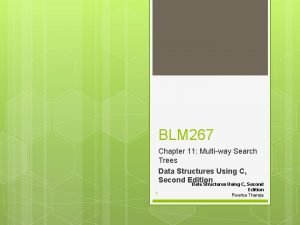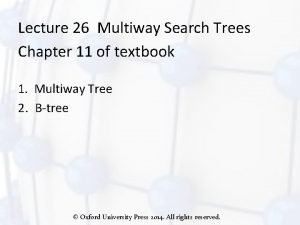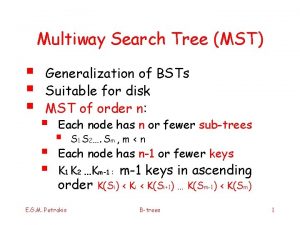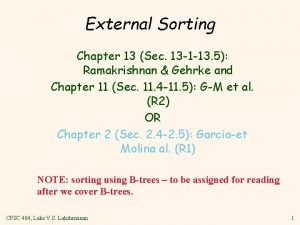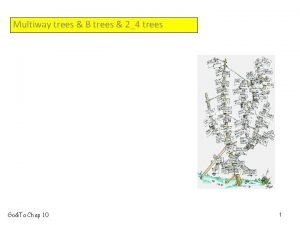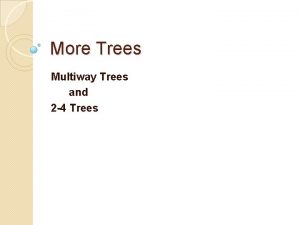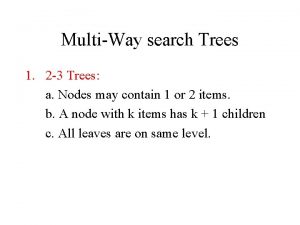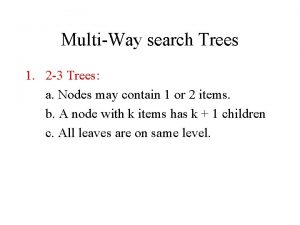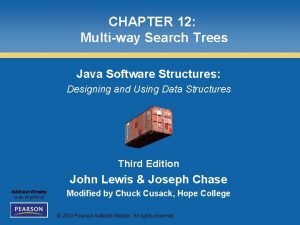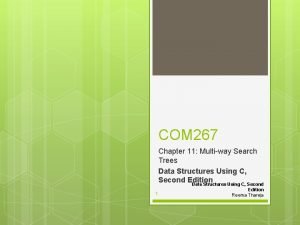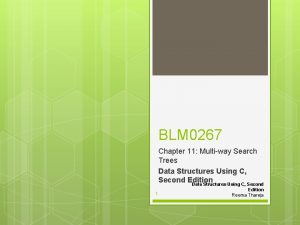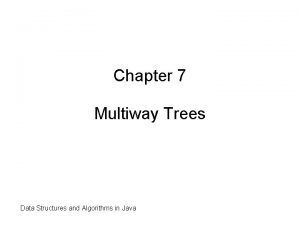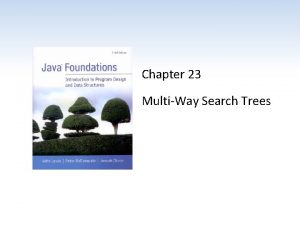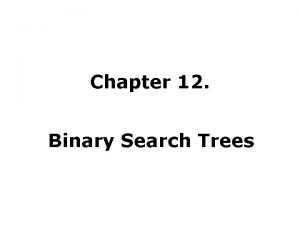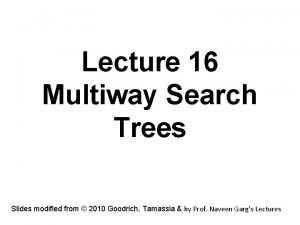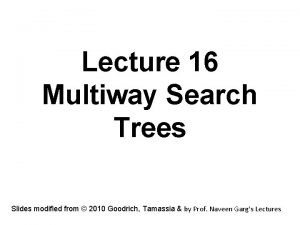Data Structures Chapter 11 Multiway Search Trees 11























- Slides: 23

Data Structures Chapter 11: Multiway Search Trees 11 -1

m-way Search Trees Definition: An m-way search tree, either is empty or satisfies the following properties: (1) The root has at most m subtrees and has the following structures: n, A 0, (K 1, A 1), (K 2, A 2), …, (Kn, An) where each Ai, 0 ≤ i ≤ n ≤ m, is a pointer to a subtree, and each Ki, 1 ≤ i ≤ n ≤ m, is a key value. (2) Ki < Ki +1, 1 i n-1 (3) Let K 0 =- and Kn+1 =. All key values in the subtree Ai are less than Ki +1 and greater than Ki , 0 i n (4) The subtrees Ai, 0 i n , are also m-way search trees. 11 -2

A Three-way Search Tree T a 20, 40 b 10, 15 c 25, 30 e 28 d 45, 50 node schematic format a b c d e 2, b, (20, c), (40, d) 2, 0, (10, 0), (15, 0) 2, 0, (25, e), (30, 0) 2, 0, (45, 0), (50, 0) 1, 0, (28, 0) 11 -3

Searching an m-way Search Tree • Suppose to search an m-way search tree T for the key value x. By searching the keys of the root, we determine i such that Ki x < Ki+1. – If x = Ki, the search is complete. – If x Ki, x must be in a subtree Ai if x is in T. – We proceed to search x in subtree Ai and continue the search until we find x or determine that x is not in T. • Maximum number of nodes in a tree of degree m and height h: • Maximum number of keys: mh 1. 11 -4

B-trees (1) Definition: A B-tree of order m is an m-way search tree that either is empty or satisfies the following properties: (1) 2 # children of root m (2) All nodes other than the root node and external nodes: m/2 # children m (3) All external nodes are at the same level. • • 2 -3 tree is a B-tree of order 3 and 2 -3 -4 tree is a B-tree of order 4. All B-trees of order 2 are full binary trees. 5

B-trees (2) • N: # of keys in a B-tree of order m and height h – Reason: Root has at least 2 children, each other node has at least m/2 children. • For example, a B-tree of order m=200 with # of keys N 2 106 2 will have h ≤ 3. 11 -6

2 -3 tree: B-tree of order 3 B 10 20 2 -3 -4 tree: B-tree of order 4 50 10 5 7 8 30 40 A 40 C 80 70 80 60 75 85 90 92 11 -7

Insertion into a B-tree of Order 5 320 540 430 480 395 406 412 451 472 493 506 511 (a) Initial portion of a B-tree 11 -8

395 430 480 382 406 412 493 506 511 451 472 (b) After inserting 382 (Split the full node) 395 430 480 508 380 382 406 412 451 472 493 506 (c) After inserting 518 and 508 511 518 11 -9

Insertion into a B-tree of Order 4 (2 -3 -4 Tree) 87 140 23 61 74 90 152 186 194 100 106 (a) An initial B-tree 97 102 140 23 61 74 90 106 (b) Inserting 102 with a left bias 152 186 194 11 -10

87 100 140 23 61 74 90 102 106 152 186 194 (c) Inserting 102 with a right bias 11 -11

Deletion from a B-tree of Order 5 (i) Rotation: Shift a key from its parent and its sibling. 80 120 150 A 90 113 126 135 142 B Delete key 113 80 126 150 A 90 120 135 142 B 11 -12

(ii) Combination: Take a key from its parent and combine with its sibling. 80 126 150 68 73 90 120 135 142 80 150 68 73 90 126 135 142 B Delete key 120 and combine B 11 -13

(iii) Combine, then rotate for its parent 60 170 30 50 A 80 150 180 220 280 C B 65 72 D 87 96 153 162 173 178 60 180 30 50 A B 150 170 187 202 Delete 65, combine and rotate 220 280 C 72 80 87 96 D 153 162 E 173 178 E 187 202 11 -14

(iv) Combine, then combine for its parent. 60 180 30 50 A B G 150 170 C D 153 162 220 280 173 178 187 202 60 300 G 30 50 A B E F Deleting 173 and a double combination 150 180 220 280 D C 153 162 170 178 E 187 202 F 11 -15

Deletion in a B-tree • The combination process may be done up to the root. • If the root has more than one key, – Done • If the root has only one key – remove the root – The height of the tree decreases by 1. • Insertion, deletion or searching in a B-tree requires O(log. N) time, where N denotes the number of elements in the B-tree. 11 -16

B+-trees • Index node: internal node, storing keys (not elements) and pointers • Data node: external node, storing elements (with their keys) • Data nodes are linked together to form a doubly linked list. A index 20 40 B 10 data 2 4 6 12 16 18 D 70 80 C 30 20 32 25 36 40 50 60 71 80 72 82 84 11 -17

Insertion into the B+-tree A 20 40 B 10 2 4 6 12 16 18 A 20 40 D 70 80 C 30 20 32 25 36 40 50 60 B 10 16 71 80 72 82 84 (a) Initial B+-tree 2 4 6 40 71 80 72 82 84 F 80 20 2 4 6 40 50 60 (b) 14 inserted (split) A B 10 16 30 12 16 20 32 14 18 25 36 G D 70 80 C C D 70 30 12 16 20 32 14 18 25 36 40 50 60 71 72 84 80 82 84 86 (c) 86 inserted E (split) 11 -18

Deletion from a B+-tree A 20 40 B 10 2 4 6 12 16 18 A 20 40 D 70 80 C 30 20 32 25 36 40 50 60 (a) Initial B+-tree B 10 16 2 4 6 B 10 16 71 80 72 82 84 A 20 40 2 4 6 30 12 16 20 32 14 18 25 36 40 50 60 72 82 80 84 (b) 71 deleted (borrow) D C 70 30 12 16 20 32 14 18 25 36 D 70 82 C 40 50 60 72 82 84 (c) 80 deleted (combine) 11 -19

Deleting 32 (1) G 40 A F 80 20 B 10 16 2 4 6 C D 70 30 12 16 20 32 14 18 25 36 40 50 60 E 84 71 72 80 82 A F 80 20 2 4 6 12 16 20 14 18 25 36 (a) Initial B+-tree G 40 B 10 16 84 86 C D 70 40 50 60 71 72 E 84 80 82 84 86 (b) C is deficient 11 -20

Deleting 32 (2) G 40 A F 80 20 B 10 16 2 4 6 C 12 16 20 14 18 25 36 D 70 E 84 40 71 50 72 60 G 40 80 82 A 2 4 6 12 14 (b) C is deficient F 80 16 B 10 84 86 C D 70 20 16 20 18 25 36 40 50 60 71 72 E 84 80 82 84 86 (c) After borrowing from B 11 -21

Deleting 86 (1) G 40 A F 80 20 B 10 16 2 4 6 C D 70 30 12 16 20 32 14 18 25 36 40 50 60 E 84 71 72 80 82 A F 80 20 2 4 6 12 16 20 14 18 25 36 (a) Initial B+-tree G 40 B 10 16 84 86 C D 70 30 40 50 60 71 72 E 80 82 84 (b) E becomes deficient (combine) 11 -22

Deleting 86 (2) G 40 A F 20 B 10 16 2 4 6 C D 70 80 30 12 16 20 32 14 18 25 36 40 50 60 71 72 (c) F becomes deficient (combine) 80 82 84 A B 10 16 2 4 6 20 40 C 30 12 16 20 32 14 18 25 36 D 70 80 40 50 60 71 72 80 82 84 (d) After combining A, G, F 11 -23
 Multiway search tree
Multiway search tree Multiway search tree
Multiway search tree 105×106
105×106 Two way selection and multiway selection
Two way selection and multiway selection Multiway selection in c
Multiway selection in c Repetition flowchart examples
Repetition flowchart examples Multiway trie
Multiway trie Mapreduce شرح
Mapreduce شرح Two phase multiway merge sort
Two phase multiway merge sort Pentaho multiway merge join
Pentaho multiway merge join Human arm and whale flipper function
Human arm and whale flipper function Ternary search tree java
Ternary search tree java Binary search trees
Binary search trees Data structures chapter 1
Data structures chapter 1 Space complexity bfs
Space complexity bfs Unified search vs federated search
Unified search vs federated search èinterest
èinterest Federated search vs distributed search
Federated search vs distributed search Informed and uninformed search in artificial intelligence
Informed and uninformed search in artificial intelligence Https://tw.images.search.yahoo.com/images/view
Https://tw.images.search.yahoo.com/images/view Best first search is a type of informed search which uses
Best first search is a type of informed search which uses Blind search dan heuristic search
Blind search dan heuristic search Yahoo search video
Yahoo search video Tw yahoo mail
Tw yahoo mail
